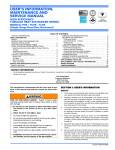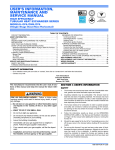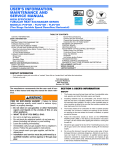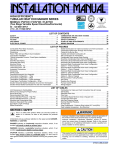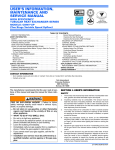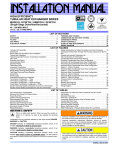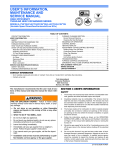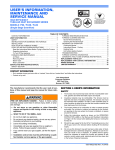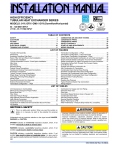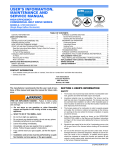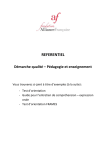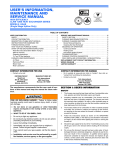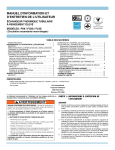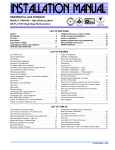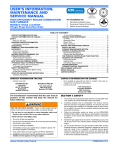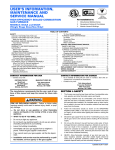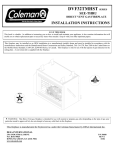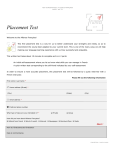Download USER`S INFORMATION, MAINTENANCE AND SERVICE MANUAL
Transcript
USER’S INFORMATION, MAINTENANCE AND SERVICE MANUAL EFFICIENCY RATING CERTIFIED HIGH EFFICIENCY TUBULAR HEAT EXCHANGER SERIES ISO 9001 Certified Quality Management System MODELS: DGAD, DGAE, DGAF (Single-Stage Downflow, 92% AFUE, Manufactured Housing or Modular Home Applications) TABLE OF CONTENTS CONTACT INFORMATION FOR USA . . . . . . . . . . . . . . . . . . . . . . CONTACT INFORMATION FOR CANADA . . . . . . . . . . . . . . . . . . . USER’S INFORMATION . . . . . . . . . . . . . . . . . . . . . . . . . . . . . . . . . . SAFETY . . . . . . . . . . . . . . . . . . . . . . . . . . . . . . . . . . . . . . . . . . . . . . INSTRUCTIONS FOR EXAMINING THE FURNACE INSTALLATION . . . . . . . . . . . . . . . . . . . . . . . . . . . . . . . HOW YOUR GAS FURNACE WORKS . . . . . . . . . . . . . . . . . . . . . . START-UP AND SHUTDOWN INSTRUCTIONS . . . . . . . . . . . . . . Read the Instructions Below Before Trying to Start the Furnace . Operating Instructions: . . . . . . . . . . . . . . . . . . . . . . . . . . . . . . . . . To Turn Off the Appliance: . . . . . . . . . . . . . . . . . . . . . . . . . . . . . . FURNACE USER MAINTENANCE . . . . . . . . . . . . . . . . . . . . . . . . . Air Filters . . . . . . . . . . . . . . . . . . . . . . . . . . . . . . . . . . . . . . . . . . . Removing Filters For Manufactured (Mobile) Home And Modular Home Installations Using A Return Air Duct System And Plenum. Removing Filters For Manufactured (Mobile) Home And Modular Home Installations Without A Return Air Duct System And Plenum. . . . . . . . . . . . . . . . . . . . . . . . . . . . . . . . . . . . . . . . . . Blower Care . . . . . . . . . . . . . . . . . . . . . . . . . . . . . . . . . . . . . . . . . Motor Lubrication . . . . . . . . . . . . . . . . . . . . . . . . . . . . . . . . . . . . . 1 1 1 1 2 3 3 3 3 3 4 4 4 4 5 5 CONTACT INFORMATION FOR USA • Contact us by mail: DISTRIBUTED BY: StyleCrest 801 W. 37th Street Building #1 Wichita, Ks 67219 SERVICE AND MAINTENANCE MANUAL . . . . . . . . . . . . . . . . . . . . .5 SAFETY SECTION . . . . . . . . . . . . . . . . . . . . . . . . . . . . . . . . . . . . . .5 FURNACE MAINTENANCE SECTION . . . . . . . . . . . . . . . . . . . . . . .5 FURNACE CLEANING SECTION . . . . . . . . . . . . . . . . . . . . . . . . . . .5 Burner Removal/Cleaning . . . . . . . . . . . . . . . . . . . . . . . . . . . . . . .5 Cleaning the Heat Exchanger . . . . . . . . . . . . . . . . . . . . . . . . . . . .6 Cleaning the Secondary Heat Exchanger . . . . . . . . . . . . . . . . . . .6 Cleaning the Vent / Air Intake System . . . . . . . . . . . . . . . . . . . . . .6 TROUBLESHOOTING . . . . . . . . . . . . . . . . . . . . . . . . . . . . . . . . . . .6 SEQUENCE OF OPERATION . . . . . . . . . . . . . . . . . . . . . . . . . . . . .6 Continuous Blower . . . . . . . . . . . . . . . . . . . . . . . . . . . . . . . . . . . . .6 Intermittent Blower - Cooling . . . . . . . . . . . . . . . . . . . . . . . . . . . . .6 Heating Cycle . . . . . . . . . . . . . . . . . . . . . . . . . . . . . . . . . . . . . . . . .6 Hot Surface Ignition System . . . . . . . . . . . . . . . . . . . . . . . . . . . . . .7 FURNACE CONTROL DIAGNOSTICS . . . . . . . . . . . . . . . . . . . . . . .7 DIAGNOSTIC FAULT CODE STORAGE AND RETRIEVAL . . . . . .8 REPLACEMENT PARTS LIST . . . . . . . . . . . . . . . . . . . . . . . . . . . . . .9 REPLACEMENT PART CONTACT INFORMATION . . . . . . . . . . . . .11 WIRING DIAGRAM . . . . . . . . . . . . . . . . . . . . . . . . . . . . . . . . . . . . . .12 LIMITED WARRANTY . . . . . . . . . . . . . . . . . . . . . . . . . . . . . . . . . . . .16 CONTACT INFORMATION FOR CANADA • MANUFACTURED BY: York International 5005 York Drive Norman, OK 73069 The manufacturer recommends that the user read all sections of this manual and keep the manual for future reference. FIRE OR EXPLOSION HAZARD - Failure to follow safety warnings exactly could result in serious injury, death, or property damage. — Do not store or use gasoline or other flammable vapors and liquids in the vicinity of this or any other appliance. — WHAT TO DO IF YOU SMELL GAS: • Do not try to light any appliance. • Do not touch any electrical switch; do not use any phone (including cell phone) in your building. • Leave the building immediately. • Immediately call your gas supplier from a neighbor’s phone. Follow the gas supplier’s instructions. • If you cannot reach your gas supplier, call the fire department. — Installation and service must be performed by a qualified installer, service agency or the gas supplier. • Go to website at www.york.com click on “contact”, then click on “contact form” and follow the instructions. Contact us by mail: York International Consumer Relations 5005 York Drive Norman, OK 73069 SECTION I: USER’S INFORMATION SAFETY 1. The furnace area must be kept clear and free of combustible materials, gasoline and other flammable vapors and liquids. 2. Insulating materials may be combustible. The furnace must be kept free and clear of insulating materials. The furnace area must be examined when installed in an insulated space or when insulation is added to be sure that the insulation material has been kept away from the furnace. 3. The furnace needs air for combustion in order to operate properly and safely. Do not block or obstruct air openings on the furnace, air openings to the area where the furnace is installed, or spaces around the furnace. 4. Follow the instructions exactly as shown on the OPERATING INSTRUCTION LABEL or the Start-up and Shutdown Instructions on Page 3 of this manual when lighting the furnace or turning the furnace off. 5. Should the gas supply fail to shut off or if overheating occurs, shut off the gas valve to the furnace before shutting off the electrical supply. 6. Do not use this furnace if any part has been under water. A flooddamaged furnace is extremely dangerous. Attempts to use the furnace can result in fire or explosion. A qualified service agency should be contacted to inspect the furnace and replace all gas controls, control system parts, electrical parts that have been wet or the furnace if deemed necessary. 268883-UUM-A-0407 268883-UUM-A-0407 COMBUSTION AIR PIPE 1. Examine the heat exchanger, through a field installed access panel located on the supply air plenum. Visually examine the exterior sections of the vent/combustion air piping and the vent connectors to be sure that they are physically sound without holes or excessive corrosion. 2. Examine the vent pipe making sure it is firmly in place, that it slopes slightly upward and is physically sound without holes and all of the connections are secure. 3. Examine return connections VENT PIPE CONDENSATE HOSE BLOWER ACCESS PANEL CONTROL BOARD RAIN GUTTER TRANSFORMER INDUCER HOUSING PRESSURE SWITCH TUBING INDUCER MOTOR • CONDENSATE TRAP GAS VALVE LIMIT SWITCH GAS REFERENCE HOSE b. If the furnace does not have a return air duct, examine the return air filter rack connections to make sure they are physically sound, sealed to the furnace casing. BURNER BOX • FIGURE 1: Component Locations 7. 8. 9. For Modular Homes: a. If the furnace has a return air duct, examine the return air duct connections to make sure they are physically sound, sealed to the furnace casing, and the ducts terminate outside the space containing the furnace. CONDENSATE DRAIN HOSE PRESSURE SWITCHES NEVER . . .Store flammable materials of any kind near your furnace. Gasoline, solvents, and other volatile liquids should be stored only in approved containers outside your home. These materials vaporize easily and are extremely dangerous. NEVER . . .Store cleaning materials near your furnace. Materials such as bleaches, detergents, powdered cleansers, etc., can cause corrosion of the heat exchangers. 4. For Manufactured (Mobile) Homes: a. Examine the return air filter rack connections to make sure they are physically sound, sealed to the furnace casing. Examine the furnace casing making sure the physical support is sound without sagging, cracks or gaps. Examine the furnace base making sure it is physically sound without cracks, gaps or sagging and has a good seal. 5. Examine the furnace casing for obvious signs of deterioration. 6. Examine the burner flames to make sure the burners look like they are operating properly. The burner flames for natural gas should appear blue with a few yellow tips. The burner flames for propane gas should appear blue with moderate yellow tips. The flame should appear cylindrical in shape and should extend from the end of the burner into the heat exchanger. Refer to the pictorial sketch shown in Figure 2 as a comparison to the actual flame. NEVER . . . Use the area around your furnace as a storage area for items which could block the normal flow of air. This flow of air is required for ventilation of the various furnace components. FIRE OR EXPLOSION HAZARD MANIFOLD MAIN BURNER This furnace is designed and approved for use with Natural Gas and (LP) Propane Gas ONLY. DO NOT BURN ANY LIQUID FUEL OR SOLID FUEL IN THIS FURNACE. END OF BURNER BURNER FLAME YELLOW TIPS Burning any unapproved fuel will result in damage to the furnace heat exchanger, which could result in Fire, Personal Injury, and/or Property Damage. INNER FLAME CONES (Blue Flame) INSTRUCTIONS FOR EXAMINING THE FURNACE INSTALLATION COMBUSTION AIR TRANSITION (not shown) It is the owner’s responsibility to ensure that an annual inspection of the entire heating portion of the unit is made by a qualified service agency. Examine the furnace as outlined below in steps “1 - 6” before each heating season. Use Figures 1, 2, & 3 for visual reference. FIGURE 2: Burner Flame Drawing 3 EXAMINE RETURN AIR DUCT CONNECTION BLOWER DOOR 2 REMOVE THIS PANEL TO EXAMINE VENT PIPE 4 EXAMINE FURNACE CASING 5 EXAMINE CASING FOR DETERIORATION 6 REMOVE THIS PANEL TO EXAMINE THE BURNER FLAMES 1 BURNER DOOR PLACE A FIELD INSTALLED ACCESS PANEL LOCATED IN THE DOWNFLOW PLENUM TO EXAMINE THE HEAT EXCHANGER 4 EXAMINE FURNACE CASING 5 EXAMINE CASING FOR DETERIORATION FIGURE 3: Furnace Examination Checkpoints 2 Unitary Products Group 268883-UUM-A-0407 HOW YOUR GAS FURNACE WORKS 8. Replace burner door. Your furnace is a very easy appliance to take for granted. Season after season, it sits there in your home, keeping you warm and comfortable. For this reason, you may never have given much thought to the way your furnace operates. In order to get the safest and most efficient operation from your furnace, you should understand how your furnace does its job. 9. Turn on all electrical power to the appliance. When you set your thermostat to provide more heat in your home, you are starting the heating cycle of the furnace. First, the inducer motor starts to purge the heat exchanger of any remaining gases. Next, the hot surface igniter glows and after a warm-up period the gas valve opens and ignition occurs. A short time later, the blower starts and distributes the warm air throughout the home. When the temperature setting on your thermostat is reached, the gas valve closes, the main burners are turned off, and the blower continues to run until the remaining warm air in the system is distributed. When the blower stops, the heating cycle has ended. To Turn Off the Appliance: A. B. C. D. This appliance does not have a pilot. It is equipped with an ignition device which automatically lights the burner. Do not try to light the burner by hand. BEFORE OPERATING; smell all around the appliance area for gas. Be sure to smell next to the floor because propane gas is heavier than air and will settle on the floor. If you smell gas refer to the WARNING box on the front cover of these instructions. Use only your hand to push the gas control switch to the “on” position. Never use tools. If the switch will not operate by hand, don’t try to repair it, call a qualified service technician. Force or attempted repair may result in a fire or explosion. 1. Set the thermostat to lowest setting. 2. Turn off all electrical power to the appliance if service is to be performed. 3. Remove burner access panel. 4. Move gas control switch to the “OFF” position. See Figure 4. 5. Replace burner access panel. Should overheating occur, or the gas valve fail to shut off, turn the external manual gas valve in the gas supply line to the furnace to the “off” position and let the furnace cool off before shutting off the electrical power supply. Refer to Figure 4. OUTLET PRESSURE PORT INLET VENT PORT OUTLET WRENCH BOSS INLET PRESSURE PORT FF O N If you do not follow these instructions exactly, a fire or explosion may result causing property damage, personal injury, and/or loss of life. 11. After three (3) trials for ignition, if the appliance will not operate follow the instructions, “TO TURN OFF THE APPLIANCE” and call your service technician or gas supplier. O START-UP AND SHUTDOWN INSTRUCTIONS Read the Instructions Below Before Trying to Start the Furnace 10. Set thermostat to the desired setting. Burner will light, which may take 30-60 seconds. ON/OFF SWITCH (Shown in OFF position) MAIN REGULATOR ADJUSTMENT FIGURE 4: Gas Valve - White Rodgers EXTERNAL MANUAL SHUTOFF VALVE Do not use this appliance if any part has been under water. Immediately call a qualified service technician to inspect the appliance and to replace any part of the control system and any gas control, which has been under water. TO GAS SUPPLY TO GAS SUPPLY Operating Instructions: 1. STOP! Read the safety information above. 2. Set the thermostat to the lowest setting. 3. Turn off all electrical power to the appliance. 4. Remove burner door. 5. Move gas control switch to the “OFF” position. Do not force. See Figure 4. 6. Wait five (5) minutes to clear out any gas. If you then smell gas, STOP! Follow “B” in the safety information above. If you don’t smell gas, go to next step. 7. Move gas control switch to the “ON” position. Do not force. See Figure 4. Unitary Products Group DRIP LEG GROUNDED JOINT UNION MAY BE INSTALLED INSIDE OR OUTSIDE UNIT. FIGURE 5: Downflow Gas Piping NOTE: The spring-loaded safety cut-off switch, mounted on the blower access panel, on the upper vestibule panel will automatically deenergize the electrical power supply to the furnace when the blower access panel is removed. As a safety precaution, all electrical power and the gas supply to the furnace should be turned off before servicing. 3 268883-UUM-A-0407 FURNACE USER MAINTENANCE Before proceeding, be sure the area is well ventilated. Turn the thermostat OFF. If the blower is running, wait until it stops automatically. Turn OFF the gas and electrical power supplies to the furnace. Check all metal parts and surfaces to be sure they have cooled to room temperature before you begin. Every time the filters are changed the following items should be visually inspected: • • • • Check combustion air and vent pipe for blockage or leakage. Check all components to be sure they are in good condition and that there are no obvious signs of deterioration. Check the drain lines to make sure there are no cracks or leaks. Check for dirt or lint on any surfaces or on components. Do not try to clean any of the surfaces or components. Cleaning of the furnace and its components must be done by a qualified service professional. If, during the inspection of your furnace, you find any of the following conditions: • Excessive amounts of dust and lint on components. • Damaged or deteriorated components or surfaces. • Leaks or blockage in the vent pipe passages. • Water on any surface inside or outside of the furnace. Do not operate the furnace, call a certified dealer / servicing contractor to check and / or clean your furnace, or for more information if you have questions about the operation of your furnace. If all components appear to be in good operating condition, replace the front panels. Turn ON the gas and electrical power supplies to the furnace, and set thermostat to the desired temperature. 1. Follow the instructions to turn off the appliance before servicing. 2. Filters that are installed in the return air plenum above the blower assembly and are located in an “V” frame assembly that supports the filters as shown in Figure 6. 3. To remove the filters you must remove the screws that are securing the access panels on the return air plenum and remove the access panels. 4. Lift the filters lightly and remove them. 5. If the filters are the throw away type you must replace the filters with filters that are the same size as the filters you removed. If you want to replace the throwaway air filters with permanent washable filters you can do so at this time. 6. If the filters are washable, follow the instructions “HOW TO CLEAN YOUR FURNACE’S FILTER”. 7. To reinstall the air filters reverse steps 1 – 6 above. 8. To place the furnace back in operation follow the operating instructions to place appliance in operation. Removing Filters For Manufactured (Mobile) Home And Modular Home Installations Without A Return Air Duct System And Plenum. Manufactured (Mobile) Home downflow furnaces and modular home furnaces not requiring a return duct system by Local, State, or Regional codes will have the filters located on the top of the furnace in an external filter rack. To check, clean or replace the air filters you should: 1. Follow the instructions to turn off the appliance before servicing 2. Filters that are installed on the top of the furnace above the blower assembly and are located in an “A” frame assembly that supports the filters as shown in Figure 6. 3. To remove the filters just slide them out of the assembly. You may have to bend the filters to slide them around the combustion air and the vent pipes. 4. If the filters are the throw away type you must replace the filters with filters that are the same size as the filters you removed. If you want to replace the throwaway air filters with permanent washable filters you can do so at this time. 5. If the filters are washable, follow the instructions “HOW TO CLEAN YOUR FILTER”. 6. To reinstall the air filters reverse steps 1 – 4 above. 7. To place the furnace back in operation follow the operating instructions to place appliance in operation. Air Filters The filters should be checked every three (3) months. On new construction, check the filters every week for the first four weeks and every three (3) weeks after that, especially if the indoor fan is running continuously. When replacing the filter(s), refer to Table 1 to be sure you install the right size filter for your furnace. Dirty filters greatly restrict the flow of air and may cause damage to the moving parts of the furnace. If the filters become clogged the heat exchangers and blower motor could overheat resulting in a potentially dangerous situation. Never operate your furnace without a suitable air filter. Use the following procedure to determine the filter size. 1. 2. Measure the furnace width and use that measurement to determine the cabinet width. • A 17-1/2” wide cabinet is a “B” cabinet. • A 21” wide cabinet is a “C” cabinet. After you determine the cabinet size and what return configuration you have, look up the recommended filter size from Table 1. Removing Filters For Manufactured (Mobile) Home And Modular Home Installations Using A Return Air Duct System And Plenum. Modular Home downflow furnaces requiring a return duct system by Local, State, or Regional Codes will have the filters located on the top of the furnace in an external filter rack located inside the return air plenum as shown in Figure 6. To check, clean or replace the air filters you should: 4 FIGURE 6: Mobile Home Filter Frame TABLE 1: Filter Sizes Cabinet Size Top Return Filter in(cm) B (2) 14 x 20 (36 x 51) C (2) 14 x 20 (36 x 51) Unitary Products Group 268883-UUM-A-0407 How to Clean your Filter High-velocity filters may be cleaned with a vacuum cleaner or washed with a garden hose. Be sure to shake off excess water and allow filter to completely dry before re-installing the filter. ELECTRIC SHOCK, FIRE OR EXPLOSION HAZARD Failure to follow safety warnings exactly could result in dangerous operation, serious injury, death or property damage. Improper servicing could result in dangerous operation, serious injury, and death or property damage. • Before servicing, disconnect all electrical power to the furnace. • When servicing controls, label all wires prior to disconnecting. Reconnect wires correctly. • Verify proper operation after servicing. To replace the filter after cleaning you must do the following: 1. Slide filter into place. 2. Snap the door on or place the door in position and tighten the retaining screws, if provided. 3. Make sure the door is secure to the end of the filter rack. 4. For filter grilles, place the filter into the grilles, close the grille cover and tighten the retaining screw. Blower Care Even with good filters properly in place, blower wheels and motors will become dust laden after long months of operation. The entire blower assembly should be inspected annually. If the motor and wheel are heavily coated with dust, they can be brushed and cleaned with a vacuum cleaner. If the blower cannot be properly cleaned without removing it from the furnace, then this service must be performed by a qualified service agency. The blower can be serviced/removed from the inside blower access panel. In order to facilitate this process the combustion air pipe inside the furnace has a 2” diameter rubber sleeve. The combustion air pipe inside the furnace is a two-pipe combination coupled together with this rubber sleeve. A similar 2” coupling provided loose with the furnace, should be used on top of the furnace to couple the combustion air pipe sticking through the casing top, with the combustion air piping. When the clamps on both of these rubber couplings are loosened, the couplings can be slid up or down the combustion air pipe. This will allow the small combustion air pipe in front of the blower housing to be removed easily. After the combustion air pipe is removed, it is easy to remove the inside blower access panel by pushing it up, against a spring. Blower is now ready to be serviced through the opening. If the blower has to be removed through the inside blower access panel, then the top flange, blower door switch and bottom flange will also have to be removed. Make sure you DO NOT move the clip-on weight on the indoor fan wheel when cleaning the wheel. This weight is used to balance the wheel. Moving the weight will cause the fan wheel to vibrate. Motor Lubrication The motors in these furnaces are permanently lubricated, and do not require periodic oiling. SECTION II: SERVICE AND MAINTENANCE MANUAL SAFETY SECTION This section has been designed to assist a qualified service agency in performing service and maintenance on this appliance. The homeowner and/or end user must never attempt to perform any service or maintenance on the appliance especially when it involves the removal or adjustment of any parts and/or components. FURNACE MAINTENANCE SECTION The furnace should be cleaned and adjusted by a certified dealer or qualified service contractor once a year or before the start of every heating season. The following items must be cleaned and serviced or replaced if there are signs of deterioration. 1. The vent terminal screen (if applicable). 2. The furnace vent and combustion air intake passageways. Should it be necessary to service the vent/air intake system, the manufacturer recommends this service be conducted by a qualified service agency. The operation of this appliance requires the reassembly and resealing of the vent/air intake system. 3. The furnace burners, ignitor and flame sensor. 4. The condensate collection and disposal system. If any disassembly of components containing flue or vent gases is required, a qualified service agency must perform the service. FURNACE CLEANING SECTION NOTE: The cleaning operations listed below must be performed only by a qualified service agency. Label all wires prior to disconnection when servicing controls. Wiring errors can cause improper and dangerous operation. Verify proper operation after servicing. Burner Removal/Cleaning The main burners should be checked periodically for dirt accumulation. If cleaning is required, follow this procedure: 1. Turn off the electrical power to the unit. 2. Turn off the gas supply at the external manual shut-off valve and loosen the ground union joint. 3. Remove the upper access panel and remove the burner box cover. 4. Disconnect wires from flame sensor, rollout switch and HSI igniter. Remove igniter carefully, as it is easily broken. 5. Remove the screws that hold the burner box assembly to the vest panel and remove the assembly. 6. Remove burners from the burner assembly. 7. Burners may be cleaned by rinsing in hot water. 8. Reassemble the burners in the reverse order. The following safety rules must be followed when servicing the furnace. Unitary Products Group 5 268883-UUM-A-0407 Cleaning the Heat Exchanger SEQUENCE OF OPERATION 1. 2. Turn off the electrical power to the unit. Turn off the gas supply at the external manual shut-off valve and loosen the ground union joint. 3. Remove the upper access panel and remove the burner box cover. 4. Disconnect wires from flame sensor, rollout switch and HSI igniter. Remove igniter carefully, as it is easily broken. 5. Remove the screws that hold the burner box assembly to the vest panel and remove the assembly. 6. Remove the vent pipe assembly, vent blower and condensate pan. 7. The heat exchanger is now exposed. 8. With a long flexible wire brush, clean inside each tube at both the top and bottom. The brush must pass around the rear heat exchanger tubes. Then vacuum loose the scale and dirt from each tube. 9. Replace all components in reverse order. Reconnect all wiring. 10. Restore electrical power and gas supply to the furnace. 11. Check furnace operation. The following describes the sequence of operation of the furnace. Refer to Figure 1 for component location. Cleaning the Secondary Heat Exchanger When the thermostat switch is set on HEAT and the fan is set on AUTO, and there is a call for heat, a circuit is completed between terminals R and W of the thermostat. When the proper amount of combustion air is being provided, the pressure switch will close, the ignition control provides a 17-second warm-up period, the gas valve then opens, the gas starts to flow, ignition occurs and the flame sensor begins its sensing function. The blower motor will energize 30 seconds after the gas valve opens, if a flame is detected. Normal furnace operation will continue until the thermostat circuit between R and W is opened, which causes the ignition system and gas valve to de-energize and the burner flames to be extinguished. The vent motor will operate for 15 seconds and the blower motor will operate for the amount of time set by the fan-off delay jumper located on the control board. See Figure 7. The heating cycle is complete, and ready for the start of the next heating cycle. 1. 2. 3. 4. 5. Follow steps 1 - 7 under cleaning the Heat Exchanger. Remove the vent piping from the vent blower housing. Disconnect the drain lines from the vent blower housing and from the condensate drain pan. Remove the vent blower housing blower and the condensate pan. Using a stiff wire brush, remove the loose scale or soot from each tube. Vacuum the secondary heat exchanger. Finish the cleaning procedure by following steps 9 - 11 under cleaning the Heat Exchanger. Cleaning the Vent / Air Intake System Should it be necessary to service the vent / air intake system, the manufacturer recommends this service be conducted by a qualified service agency. The operation of this appliance requires the reassembly and resealing of the vent / air intake system as specified in the “Combustion Air and Vent System” located in the Installation Manual. TROUBLESHOOTING The following visual checks should be made before troubleshooting: 1. Check to see that the power to the furnace and the ignition control module is ON. 2. The manual shut-off valves in the gas line to the furnace must be open. 3. Make sure all wiring connections are secure. 4. Review the sequence of operation. Start the system by setting the thermostat above the room temperature. Observe the system’s response. Then use the troubleshooting section in this manual to check the system’s operation. Never bypass pressure switch to allow furnace operation. To do so will allow furnace to operate under potentially hazardous conditions. Do not try to repair controls. Replace defective controls with UPG Source 1 Parts. Never adjust pressure switch to allow furnace operation. 6 Continuous Blower Cooling/heating thermostats have a fan switch that has an ON and AUTO position. In the ON position the thermostat circuit is completed between terminals R and G. The motor will operate on the speed tap wire that is connected to the “HI COOL” cooling terminal on the control board. To obtain a constant air circulation at lower flow rate, change the high-speed wire to either the medium speed wire or the low speed wire. Intermittent Blower - Cooling Cooling/heating thermostats have a fan switch that has an ON and AUTO position. In the AUTO position the thermostat circuit is completed between terminals R and G when there is a call for cooling. The motor will operate on the speed tap wire that is connected to the “HI COOL” cooling terminal on the control board. The fan off setting is fixed at 60 seconds to improve cooling efficiency. Heating Cycle If the flame is not detected within 2 seconds of the gas valve opening, the gas valve is shut off and a retry operation begins. If the flame is lost for 2 seconds during the 10-second stabilization period, the gas valve is shut off and a retry operation begins. During a retry operation, the vent motor starts a 15 second inter-purge and the ignitor warm-up time is extended to 27 seconds. If the flame is established for more than 10 seconds after ignition during a retry, the control will clear the ignition attempt (retry) counter. If three retries occur during a call for heat, the furnace will shut down for one hour. If at the end of the one hour shut down there is a call for heat, the furnace will initiate a normal start cycle. If the problem has not been corrected the furnace will again lockout after three retries. A momentary loss of gas supply, flame blowout, or a faulty flame probe circuit will result in a disruption in the flame and be sensed within 1 second. The gas valve will de-energize and the control will begin a recycle operation. A normal ignition sequence will begin after a 15 second interpurge. If during the five recycles the gas supply does not return, or the fault condition is not corrected the ignition control will lockout for one hour. During burner operation, a momentary loss of power for 50 milliseconds or longer will de-energize the gas valve. When the power is restored, the gas valve will remain de-energized and the ignition sequence will immediately restart. Unitary Products Group 268883-UUM-A-0407 TWIN YELLOW-MED. LOW PARK PARK RED-LOW Y/Y2 60 90 BLOWER OFF 120 DELAY 180 FAN OFF ADJUSTMENT JUMPER HI COOL HEAT BLACK-HI BLUE-MED. HI W EAC-H R G L1 C XFMR NEUTRALS HUM FIGURE 7: Furnace Control Board Hot Surface Ignition System HOT SURFACE IGNITION SYSTEM Do not attempt to light this furnace by hand (with a match or any other means). There may be a potential shock hazard from the components of the hot surface ignition system. The furnace can only be lit automatically by its hot surface ignition system. FURNACE CONTROL DIAGNOSTICS The furnace has built-in, self-diagnostic capability. If a system problem occurs, a blinking LED shows a fault code. The LED can flash red, green or amber to indicate various conditions. It is located behind a clear view port in the blower compartment door. The control continuously monitors its own operation and the operation of the system. If a failure occurs, the LED will indicate the failure code. If the failure is internal to the control, the light will stay on continuously. In this case, the entire control should be replaced, as the control is not field repairable. Flash sequence codes 1 through 11 are as follows: LED will turn “on” for 1/4 second and “off” for 1/4 second. This pattern will be repeated the number of times equal to the code. For example, six “on” flashes equals a number 6 fault code. All flash code sequences are broken by a 2 second “off” period. SLOW GREEN FLASH: Normal operation. SLOW AMBER FLASH: Normal operation with call for heat. RAPID RED FLASH: Twinning error, incorrect 24V phasing. Check twinning wiring. RAPID AMBER FLASH: Flame sense current is below 1.5 microamps. Check and clean flame sensor. Check for proper gas flow. Verify that current is greater than 1.5 microamps at flame current test pad. 4 AMBER FLASHES: The control board is recieving a “Y” signal from the thermostat without a “G” signal, indicating improper thermostat wiring. 1 RED FLASH: This indicates that flame was sensed when there was not a call for heat. With this fault code the control will turn on both the inducer motor and supply air blower. A gas valve that leaks through or is slow closing would typically cause this fault. Unitary Products Group 2 RED FLASHES: This indicates that the normally open pressure switch contacts are stuck in the closed position. The control confirms these contacts are open at the beginning of each heat cycle. This would indicate a faulty pressure switch or miswiring. 3 RED FLASHES: This indicates the normally open pressure switch contact did not close after the inducer was energized. This could be caused by a number of problems: faulty inducer, blocked vent pipe, broken pressure switch hose or faulty pressure switch. 4 RED FLASHES: This indicates that a primary or auxiliary limit switch has opened its normally closed contacts. With this fault code the control will operate the supply air blower and inducer. This condition may be caused by: dirty filter, improperly sized duct system, incorrect blower speed setting, incorrect firing rate or faulty blower motor. 5 RED FLASHES: This fault is indicated if the normally closed contacts in the rollout switch opens. The rollout control is manually reset. If it has opened, check for proper combustion air, proper inducer operation, and primary heat exchanger failure or burner problem. Be sure to reset the switch and cycle power (24 VAC) to the control after correcting the failure condition. 6 RED FLASHES: This indicates that after the unit was operating, the pressure switch opened 4 times during the call for heat. If the main blower is in a “Delay on” mode, it will complete it, and any subsequent delay off period. The furnace will lock out for one hour and then restart. 7 RED FLASHES: This fault code indicates that the flame could not be established. This no-light condition occurred 3 times (2 retries) during the call for heat before locking out. Low gas pressure, faulty gas valve, dirty or faulty flame sensor, faulty hot surface ignitor or burner problem may cause this. The furnace will lock out for one hour and then restart. 8 RED FLASHES: This fault is indicated if the flame is lost 5 times (4 recycles) during the heating cycle. This could be caused by low gas pressure, dirty or faulty flame sensor or faulty gas valve. The furnace will lock out for one hour and then restart. 9 RED FLASHES: Indicates reversed line voltage polarity or grounding problem. Both heating and cooling operations will be affected. Check polarity at furnace and branch. Check furnace grounding. Check that flame probe is not shorted to chassis. 10 RED FLASHES: Gas flow with no call for heat. Check gas valve and gas valve wiring. 7 268883-UUM-A-0407 11 RED FLASHES: This indicates that a primary or auxiliary limit switch has opened its normally-closed contacts and has remained open for more than five minutes. This condition is usually caused by a failed blower motor or blower wheel. Cycle power (24 VAC) to the control to reset the hard lockout condition after correcting the failure condition. 12 RED FLASHES: This code indicates an open igniter circuit, which could be caused by a disconnected or loose wire or by a cracked or broken igniter. STEADY ON RED: Control failure. Replace control board. 60-MINUTE AUTOMATIC RESET FROM LOCKOUT: This control includes a “watchdog” type circuit that will reset from a lockout condition after 60 minutes. Operational faults 6,7,8 will be reset. This provides protection to an unoccupied structure if a temporary condition exists causing a furnace malfunction. An example would be a low incoming gas supply pressure preventing unit operation. When the gas pressure is restored, at some point the “watchdog” would restart the unit and provide heat for the house. NOTE: If a flame is detected the control flashes the LED for 1/8 of a second and then enters a flame stabilization period. IGNITION CONTROL (P/N 031-01972-000) Normal flame sense current is approximately 3.7 microamps DC (µa) Low flame signal warning starts at 1.5 microamps. Low flame signal control lockout point is 0.1 microamps DC (µa) DIAGNOSTIC FAULT CODE STORAGE AND RETRIEVAL The control in this furnace is equipped with memory that will store up to five error codes to allow a service technician to diagnose problems more easily. This memory will be retained even if power to the furnace is lost. This feature should only be used by a qualified service technician. The control stores up to five separate error codes. If more than five error codes have occurred since the last reset, only the five most recent will be retained. The furnace control board has a button, labeled "LAST ERROR" that is used to retrieve error codes. This function will only work if there are no active thermostat signals. So any call for heating, cooling or continuous fan must be terminated before attempting to retrieve error codes. To retrieve the error codes, push the LAST ERROR button. The LED on the control will then flash the error codes that are in memory, starting with the most recent. There will be a two-second pause between each flash code. After the error codes have all been displayed, the LED will resume the normal slow green flash after a five second pause. To repeat the series of error codes, push the button again. If there are no error codes in memory, the LED will flash two green flashes. To clear the memory, push the LAST ERROR button and hold it for more than five seconds. The LED will flash three green flashes when the memory has been cleared, then will resume the normal slow green flash after a five-second pause. Thermostat Satisfied Thermostat Calling for Heat (Seconds) 0 2 17 52 22 0 Fan on Delay 30 Seconds ON THERMOSTAT OFF OFF ON INDUCER OFF IGNITOR OFF 15 Sec. Post Purge ON OFF OFF OFF ON MAIN VALVE OFF OFF ON HUMIDIFIER OFF ELECTRONIC AIR CLEANER CIRCULATING BLOWER OFF OFF ON OFF OFF OFF ON OFF OFF 60, 90, 120, 180 SEC. OFF Selectable Fan Off Delay FIGURE 8: Furnace Control Event Schedule 8 Unitary Products Group 268883-UUM-A-0407 SECTION III: REPLACEMENT PARTS LIST 32 17 54 7 27 53 13 74 43 2 61 71 70 11 18 66 43 5 34 44 29 31 10 14 26 9 37 15 16 56, 57 1 3 64 50 24 47 46 58 2 21 20 60 25 14 22 4 5 28 48 49 6 42 51 30 41 6 19 30 65 41 33 36 42 79 10 A 6 28 9, 37 45 A Unitary Products Group 44 40 14 23 28 SECTION A-A 9 268883-UUM-A-0407 ITEM DESCRIPTION MOTOR ITEM 1 MOTOR, DIRECT DRIVE BLOWER 41 2 MOTOR, INDUCER ASSEMBLY 42 COMBUSTION AIR TRANSITION 43 TUBING, SILICONE (Gray, .188 ID, 2.83 ft. req’d) ELECTRICAL CAPACITOR, RUN (7.5 MFD / 370 V) CAPACITOR, RUN (10 MFD / 370 V) 44 TUBING, SILICONE (Preformed) 45 TUBING, SILICONE (Gray, .188 ID, 1.25 ft. req’d) 4 SWITCH, LIMIT (INDUCER) 46 GASKET, COMBUSTION BLOWER 5 LIMIT, TEMPERATURE (Primary) 47 GASKET, CONDENSATE PAN 6 LIMIT, FLAME ROLL-OUT 48 GASKET, UPPER CONDENSATE PAN (2 req’d) GASKET, GAS CONTROLS 7 CONTROL, FURNACE MODULE 49 8* FUSE 50 GASKET, CONDENSER COIL 9 IGNITER 51 GASKET, COMBUSTION AIR TRANSITION 10 SENSOR, FLAME 52* GASKET, MOUNTING BRACKET (Burner Box) 11 SWITCH, PRESSURE 53 COMBUSTION AIR INTAKE ASSEMBLY 12 SWITCH, DOOR 54 VENT PIPE 2” X 15.25” LG. 13 TRANSFORMER 55* RUBBER SLEEVE 2.5” X 4” LG. 14 VALVE, GAS 56 GROMMET, MOTOR (3 req’d) 57 FERRULE (3 req’d) 15 HOUSING, BLOWER 58 COMBUSTION BLOWER RESTRICTOR 16 WHEEL, BLOWER 59* SPRING, DOOR FABRICATED PARTS 60 WASHER, FLAT FIBERGLASS (2 req’d) HANDLE, DOOR (3 req’d) 17 PANEL, BLOWER COVER 61 18 BRACKET, CONDENSATE TRAP 62* CLAMP, HOSE (2 req’d) 19 BURNER, MAIN GAS 63* HARNESS, MAIN WIRING 20 COIL, CONDENSING 64 MOUNT, 1 PC. MOTOR 21 SHELF, BLOWER 65 ORIFICE, BURNER (Natural #45) 22 HEAT EXCHANGER ASSEMBLY 66 TRAP, CONDENSATE 23 MANIFOLD, GAS 67* WIRING DIAGRAM 24 SHIELD, PAN 68* 45 STREET ELBOW 2” 25 PAN, CONDENSATE 69* DRAIN TUBE, CONDENSATE TRAP 26 PANEL, LOWER ACCESS 70 DRAIN TUBE COMBUSTION BLOWER 27 ACCESS PANEL, UPPER 71 DRAIN TUBE, CONDENSATE PAN 28 WRAPPER, BURNER BOX 72* DRAIN TUBE, STRAIGHT 21” LG. 29 CHANNEL, TOE PLATE 73* DRAIN TUBE, RAIN GUTTER 30 COVER, GAS CONTROL 74 DRAIN HOSE ASSEMBLY 31 BOTTOM PANEL 75* LOCKNUT, CONDUIT (1/2”) 32 PANEL, TOP 76* ADAPTER, INSERT 33 SUPPORT, BURNER 77* BUSHING, THREADED 34 WRAPPER, CABINET 78* FILTER, AIR (2 req’d) FILTER SIZE 35 10 PLUG, WINDOW, CLEAR - 1.5” 3 AIR MOVING NOTE: DESCRIPTION MISCELLANEOUS 36 PLATE, DIFFUSER 79 BURNER BOX BAFFLE 37 BRACKET, IGNITER 80* GROMMET, MANIFOLD 38* BRACKET, DOOR SWITCH 81* VENT PIPE ASSEMBLY 39* DOOR BRACKET 82 DRAIN TUBE, VENT PIPE 40 BOTTOM PANEL, BURNER BOX 83 LOGO/BEZEL PLATE ASSY *Not Shown Major components and suggested stocking items are shown with shaded item number. Unitary Products Group 268883-UUM-A-0407 MODEL NO. FIELD INSTALLED ACCESSORIES - NON-ELECTRICAL DESCRIPTION USED WITH 1CT0302 CONCENTRIC INTAKE/VENT 2” ALL MODELS 1CT0303 CONCENTRIC INTAKE/VENT 3” ALL MODELS 1PS0901 60/100 1PS0903 HIGH ALTITUDE PRESSURE SWITCH KIT (Does Not Include Orifices) 1NK0301 CONDENSATE NEUTRALIZER KIT ALL MODELS 1HT0901 SIDEWALL VENT TERMINATION KIT 3” ALL MODELS 1HT0902 SIDEWALL VENT TERMINATION KIT 2” 1CB0317 1CB0321 COMBUSTIBLE FLOOR BASE 1TK0917 1TK0921 1VK0901 COIL TRANSITION KIT 3-WAY TRANSITION KIT 80 ALL MODELS 17-1/2” CABINET 21” CABINET 17-1/2” CABINET 21” CABINET All MODELS REPLACEMENT PART CONTACT INFORMATION This is a generic parts list. To request a complete parts list, refer to the contact information below: • Visit our website at www.source1parts.com for the following information: 1. Search for a part or browse the catalog. 2. Find a dealer or distributor. 3. Customer Service contact information. a. Click on the “Brand Links” button b. Click on the “Customer Service” button • You can contact us by mail. Just send a written request to: York International Consumer Relations 5005 York Drive Norman, OK 73069 Unitary Products Group 11 268883-UUM-A-0407 SECTION IV: WIRING DIAGRAM FIGURE 9: Wiring Diagram 12 Unitary Products Group 268883-UUM-A-0407 NOTES Unitary Products Group 13 268883-UUM-A-0407 NOTES 14 Unitary Products Group 268883-UUM-A-0407 NOTES Unitary Products Group 15 Limited Warranty Manufactured Housing Furnace UPG warrants this product to be free from defects in factory workmanship and material under normal use and service and will replace parts that prove to have such defects according to the terms outlined below. FURNACE MODELS Furnace Model Heat Exchanger Parts Coverage Labor and Trip Coverage* 15 years 2 years 2 years DGAD, DGAE, DGAF (92% Downflow) *Thermostat labor coverage for 30 days only, no trip allowance. The warranty period for any replacement heat exchanger or part provided here under shall not extend beyond the warranty period stated above. The heat exchanger warranty is on a parts only basis: no labor, freight or other service charges are allowed. The warranty period will begin on the purchase date of the residence when the product is installed as original equipment, or the installation date when installed in a residence previously purchased by the consumer. Return the Warranty Registration Card to UPG promptly after product installation or purchase for your benefit and protection. The warranty period will begin upon product shipment from UPG in the absence of a recorded Warranty Registration Card. This warranty applies to the original consumer/purchaser and any subsequent purchaser. The warranty does not apply if the furnace is removed from the original residence, or if the residence has been moved from the original location where the furnace was placed in service. This warranty applies only to products installed: (1) in the United States of America or Canada; (2) in accordance with UPG recommendations and specifications outlined in the Installation Manual provided with the product; (3) in accordance with all national, state/provincial, and local codes; and (4) in the original residence. Exclusions 1. Shipping/freight, or material charges. 2. Damages resulting from transportation, mishandling, improper application, installation or servicing. 3. Damages resulting from accident, abuse, fire, flood, or other acts of nature. 4. Use of the product in a corrosive atmosphere. 5. Alteration, tampering, defacing or removing the product serial number will serve to void the warranty. 6. Damages resulting from inadequacy or interruption of electrical service, improper energy supply, blown fuses, improper wiring external to the unit or other like damages. 7. Damages resulting from the use of components not approved by UPG. 8. This warranty does not cover consequential damages, incidental damages or incidental expenses including damages to property. 9. Damages caused by failure to perform normal or routine maintenance as set out in the operation and service instructions. 10. Cleaning, replacement of filters, or any other routine maintenance as set out in the User’s Information, Maintenance and Service Manual. 11. Replacement or cleaning of nozzles or orifices. 12. Fuses either internal or external to the product. 13. Excessive fuel or electricity consumption. THIS WARRANTY IS IN LIEU OF ALL OTHER WARRANTIES, EXPRESSED OR IMPLIED, INCLUDING THE IMPLIED WARRANTIES OF MERCHANTABILITY AND FITNESS FOR A PARTICULAR PURPOSE. SOME STATES DO NOT ALLOW THE DISCLAIMER OF IMPLIED WARRANTY, SO THAT THE ABOVE DISCLAIMER MAY NOT APPLY TO YOU. SOME STATES ALLOW ONLY A PARTIAL LIMITATION ON IMPLIED WARRANTIES, OR LIMIT THE DURATION OF IMPLIED WARRANTIES TO THE DURATION OF THE EXPRESS WARRANTY. IN SUCH STATES, THE DURATION OF IMPLIED WARRANTIES IS HEREBY EXPRESSLY LIMITED TO THE DURATION OF THE EXPRESS WARRANTY ON THE FACE HEREOF. IN NO EVENT, WHETHER AS A RESULT OF BREACH OF WARRANTY OR CONTRACT TORT (INCLUDING NEGLIGENCE) STRICT LIABILITY OR OTHERWISE, SHALL UPG BE LIABLE FOR SPECIAL, INCIDENTAL, OR CONSEQUENTIAL DAMAGES, INCLUDING BUT NOT LIMITED TO LOSS OF USE OF THE EQUIPMENT OR ASSOCIATED EQUIPMENT, LOST REVENUES OR PROFITS, COST OF SUBSTITUTE EQUIPMENT. THIS WARRANTY DOES NOT COVER CONSEQUENTIAL DAMAGES. THE ABOVE LIMITATIONS SHALL INURE TO THE BENEFIT OF UPG SUPPLIERS AND SUBCONTRACTORS. THE ABOVE LIMITATION ON CONSEQUENTIAL DAMAGES SHALL NOT APPLY TO INJURIES TO PERSONS IN THE CASE OF CONSUMER GOODS. SOME STATES DO NOT ALLOW THE EXCLUSION OR LIMITATION OF LIABILITY FOR CONSEQUENTIAL OR INCIDENTAL DAMAGES, OR FOR STRICT LIABILITY IN TORT, SO THAT THE ABOVE EXCLUSIONS AND LIMITATIONS MAY NOT APPLY TO YOU. UPG DOES NOT ASSUME, OR AUTHORIZE ANY PERSON TO ASSUME FOR UPG ANY LIABILITY FOR THE SALE OF THIS PRODUCT. THIS WARRANTY GIVES YOU SPECIFIC LEGAL RIGHTS. YOU MAY ALSO HAVE OTHER RIGHTS WHICH VARY FROM STATE TO STATE. TO OBTAIN WARRANTY SERVICE Consult the Authorized Service Center list packed with the furnace installed in the manufactured home or contact your installing or servicing dealer. Or, look in the Yellow Pages of the telephone book under Mobile Homes-or Manufactured Housing-Repair and Service for the name and telephone number of the nearest authorized manufactured housing service center. If local authorized service cannot be obtained, or you are unable to contact your installing dealer, contact the authorized distributor in your area. If there is no distributor in your area, and you cannot obtain proper service under the terms of the warranty, please write: Unitary Products Group (UPG) Customer Relations Department, PO Box 19014, Wichita, KS 67204-9014. Subject to change without notice. Printed in U.S.A. Copyright © by York International Corp. 2007. All rights reserved. Unitary Products Group 268883-UUM-A-0407 Supersedes: 167810-UUM-C-0506 P. O. Box 19014 Wichita KS 67204-9014
















